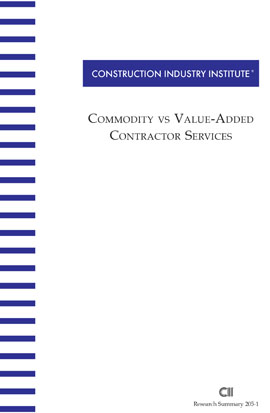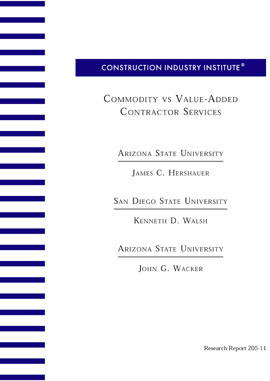
Commodity vs Value-Added Contractor Services
The engineering and construction industry continues to grapple with the issue of “value-added services.” Are such services really value added or are they simply commodities to be purchased on the open market under competitive bidding procedures? A primary problem is the fact that owners and contactors use different terminologies and definitions when discussing this controversial issue. As a result, both parties often become frustrated with each other. Because of the varying definitions used by industry practitioners, miscommunication not only occurs between owner and contractor, but also within their own organizations.
As a way to overcome this communication barrier and to achieve an objective basis to conduct a detailed study, CII established the Commodity vs. Value-Added Contractor Services Research Team to develop a set of common definitions. The effort by the research team includes the following terms:
- Value – benefits provided (used with modifiers such as market value, perceived value).
- Value-added – marginal increase in value created by features or functions of a good or service.
- Net value-added – value in relation to its associated cost.
- Differentiation – dissimilarity of the features and functions of a good or service.
- Commodity – undifferentiated good or service.
Once the common definitions were established, the research team conducted a series of workshops with the two targeted groups isolated from each other. Although some criticism of the other side occurred during these workshops, comments during breaks tended to be similar to this quote from a contractor:
“We are often are own worst enemy and force the owners to treat us as a commodity.”
A quote from an owner also is similar:
“We do not do a good job of articulating what features and functions provide benefits and thus the bid process is both vague and ambiguous for contractors.”
Following the workshops, the research team conducted a case study of a number of projects at one company and then analyzed data from a large number of projects from both owner and contractor pairs to identify which offerings in the bid really added value and which did not.
The results are surprising in that many services believed relatively important by contractors in making project proposals are not viewed as important by the owners evaluating the bids. The converse holds true in that some relatively important criteria from the owner’s perspective are not viewed with the same importance by the contractor.
Three of the most important conclusions drawn by the team from its study are:
- The industry needs to use common definitions.
- Contractors and owners should be aware that many service offerings relate to value-added; however, only a select few actually contribute to net value-added.
- The more the owner emphasizes price as the deciding factor, the less net value-added is actually realized.
The team also concludes that value can only be measured from an owner’s perspective. And, just as important, if owners are buying on price, they are missing net value-added. An overview of these problems and some possible solutions are discussed in the following chapters.
The research defined 12 categories of differentiators and identified several key differentiators which are statistically linked to net value-added. These fall under seven of the 12 categories:
- Risk Management
- Facility Operating Performance
- Customer Relations
- Safety
- Financial Considerations
- Delivery Methodology
- Quality Management
The team additionally identified differentiators that actually detract from net value-added, both at the pre-qualification and the final bidding stages.
(RS205-1, pp. 30-31)RS205-1, Communication and Evaluation Tool
This tool can be used by both owners and contractors. For example, owners can use the tool to: (Appendix B)
- Identify and communicate the primary functional capabilities they are seeking from their contractors, along with importance weighting.
- Compare their assessment of the contractor’s capabilities vs. the contractor’s self-assessment. Significant differences can be used to guide in-depth assessment and communication.



